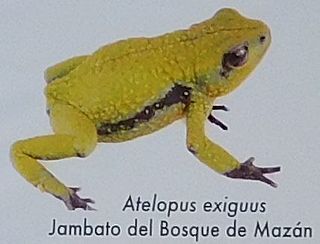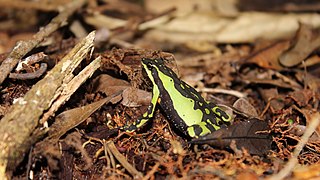
Atelopus longirostris is a species of harlequin frog, a member of the family of true toads (Bufonidae). It has been recorded only in northern Ecuador. Records from Colombia probably represent different species. As of mid-2017, it is listed as extinct by the IUCN, but was rediscovered in 2016 after more than two decade with no sightings, likely because the IUCN last assessed it in 2004. The scientific name of this species means "long-snout" and the species has been named in Spanish as the jambato hocicudo. Common names longnose stubfoot toad, scrawny stubfoot-toad, and longnose sharlequin frog have been coined for it.

Atelopus exiguus is a species of toad in the family Bufonidae. It is endemic to Ecuador and only known from the area of its type locality in the Azuay Province of southern Ecuador, in the sub-páramo and páramo of Cordillera Occidental. Common name Mazán jambato frog has been proposed for it.
Atelopus monohernandezii is a species of toads in the family Bufonidae. It is endemic to Colombia and only known from the vicinity of its type locality on the western slope of the Cordillera Oriental, Santander Department. It has not been observed after 1982 and the remaining population is believed to be very small, if surviving at all.

Atelopus mucubajiensis, also known as the Mucubaji stubfoot toad, is a species of toad in the family Bufonidae. It is endemic to the Mérida Andes of Venezuela. This once abundant species was last observed in 2004. It is likely extinct.
Atelopus pachydermus is a species of toad in the family Bufonidae. It is found in the Andes of northern Peru and southern Ecuador. Records from Colombia reflect the vagueness of the stated type locality, "Neu-Granada", encompassing territory part of several present-day countries. Other records outside the current range refer to other species. The most recent record of this very rare and possibly extinct species is from around 1995. However, there is a need to reassess the status of this species because of confusion with Atelopus podocarpus.
Atelopus planispina is a species of toad in the family Bufonidae. It is endemic to the eastern slopes of the Andes of Ecuador. According to the IUCN SSC Amphibian Specialist Group, it is restricted to the Napo Province, although other sources suggest somewhat wider range. It has not been seen since 1985 and might already be extinct. Common names Planispina's harlequin frog, Napo stubfoot toad, and flat-spined atelopus have been coined for it.

Atelopus pulcher is a species of toad in the family Bufonidae. It is endemic to eastern Peru where it is found in the Huallaga River drainage; its range might extend to Ecuador. Its natural habitats are lowland and premontane tropical forests. It is a diurnal and terrestrial species that breeds in streams.
Atelopus vogli is an extinct species of harlequin frog in the family Bufonidae. It was endemic to Venezuela. It is known from collections in two localities: its type locality, Las Peñas near Hacienda la Trinidad in Aragua, and Montalbán in Carabobo. It was first described as subspecies of Atelopus cruciger. The specific name vogli honours Cornelius Vogl, German priest who was a missionary in Venezuela in 1925–1959. Common name Vogl's harlequin toad has been coined for it.
Callimedusa duellmani is a species of frog in the subfamily Phyllomedusinae. It is endemic to Peru and is only known from its type locality near Balzapata, upper Chiriaco River, in the Department of Amazonas. The specific name duellmani honors William E. Duellman, an American herpetologist. Common name purple and orange leaf frog has been proposed for it.
Craugastor adamastus is a species of frog in the family Craugastoridae. It is endemic to Guatemala and only known from its type locality near Aldea Vista Hermosa, on the northern slopes of the eastern portion of the Sierra de las Minas, where the type series was collected in 1980–1981.

Atelopus petersi is a species of toad in the family Bufonidae. It is endemic to Ecuador and is known from the Cordillera Oriental in the Napo Province and more provisionally, in the Chimborazo Province. The specific name petersi honors James A. Peters, an American zoologist who collected the first specimens of this species in 1962 and provided a description under the name Atelopus pachydermus. Common names Peters' stubfoot toad and Peters' jambato toad have been coined for it.
Atelopus eusebiodiazi is a species of toads in the family Bufonidae. It is endemic to north-western Peru and only known from its type locality in Huamba, near Ayabaca, Piura Region. The specific name eusebiodiazi honors Eusebio Diaz, taxidermist at the Museum of Natural History, Lima, and the collector of the holotype.
Atelopus onorei is a small species of bright yellow and green toads in the family Bufonidae. It is endemic to Ecuador and is only known from the vicinity of its type locality on the western slope of the Cordillera Occidental in the Azuay Province. It has not been seen since 1990 and may now be extinct, but it is possible that overlooked populations remain.
Atelopus pyrodactylus is a species of toad in the family Bufonidae. It is endemic to Peru and only known from its type locality in the northern section of the Río Huallaga basin, Department of San Martín, on the eastern slope of the Cordillera Central. The specific name pyrodactylus refers to the light orange fingers and toes of this frog.

Noblella madreselva is a species of frog in the family Strabomantidae. The species is only known from its type locality, Madre Selva in the La Convención Province, Cusco, Peru.

Psychrophrynella chirihampatu is a species of frogs in the family Strabomantidae. It is endemic to Peru and known only from its type locality, the Japumato Valley in the Peruvian Andes of the Cusco. The common name Japumayo Andes frog has been coined for this species.
Ansonia teneritas, the gracile slender toad, is a species of toad in the family Bufonidae, described in 2016. It is endemic to central Sarawak in Malaysian Borneo and is only known from two isolated mountain ridges. Its name is derived from its slender body.
Atelopus gigas is a species of frog in the family Bufonidae. It has not been seen since 1970 and is considered possibly extinct.
Telmatobius mantaro is a species of frog in the family Telmatobiidae. It is endemic to the eastern Cordillera Central of the Peruvian Andes. The specific name mantaro refers to the Mantaro River running near the type locality.
Atelopus nocturnus, also known as the nocturnal harlequin toad, is a species of frog in the family Bufonidae. It is endemic to Antioquia, Colombia, and only known from its type locality in Anorí, in the northern Cordillera Central. The specific name nocturnus refers to the nocturnality of this species, which is unusual among Atelopus.








